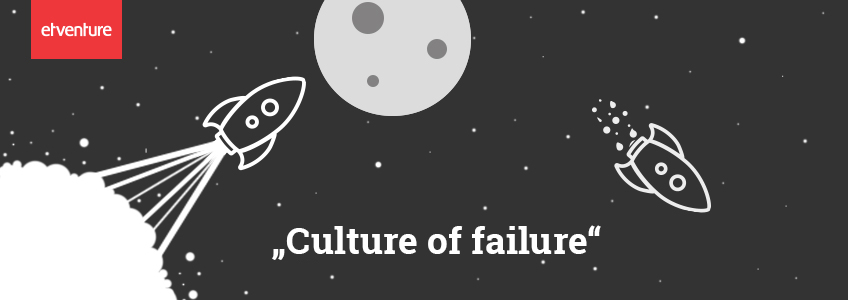The Value of Failure
27. April 2017
In the last few years, the concept of a “culture of failure” has appeared in the business community. Economists praise the culture of making mistakes as an important success factor and founders of start-ups celebrate their failures at “fuck-up nights”. Failure has come into fashion. So, should the aim be to fail? Are failures a quality factor for corporate activity. Of course not.
Failure should not be seen as an aim in itself. Anyone who negligently steers their start-up into bankruptcy or takes naive risks that are not in proportion to the relevant opportunities is simply not doing a good job. And yet, promoting a positive culture of failure is absolutely justified. However, not in indiscriminate phrases like “Make more mistakes!”. Instead, you need to understand the extent to which mistakes can foster real value.
Culture of failure in German companies – avoid rather than take a chance
“We would rather give money to a founder who has already had one or two failures”. Silicon Valley Investor Corey Ford uses this principle to describe his investment strategy ‒ a statement that would probably irritate almost every German manager. Because, in Germany, perfection is still highly valued. There is hardly any room for “underachievers”.
Fear of failure is similarly pronounced in German companies. The “white shirt syndrome” frequently rules at the management level in companies. This means that nobody wants to take responsibility for possible failures in case they effectively amount to a stain on their personal career path. And so the widespread recipe for success for prospective CEOs is – never fail. People who wants to make a career out of this risk-avoidance strategy will also only let risks be taken in very small steps when they are leading a business – and the same also applies to opportunities. And that is dangerous.
What is the value of failure?
Start-ups have a different view. Taking risks is an everyday activity for founders. Right from the start they accept a success rate of significantly below 50 per cent. That means they have to anticipate their failure before they have even started, which is a completely contrary viewpoint.
The key characteristic of a start-up is thus dealing with uncertain situations. They don’t know whether they have developed the right product for the right market. They don’t know which marketing strategy will work. They even don’t know whether the target customer will actually buy their product. Each element of their business plan is merely a hypothesis that needs testing. This realisation formed the basis for the Lean Startup Methodology and thus also for the success stories of leading digital companies such as Google, Apple, AirBnB, Uber and Facebook.
Conversely, this does not, however, mean that it is not per se a mistake if an idea, an approach or an action does not work. It is merely the negative validation of the relevant hypothesis. Is it just an excuse to conceal one’s failure? And to what extent should value be created as a result.
Fake it till you make it
Imagine that a manufacturer wants to launch a new product onto the market. Let’s assume that the product is ultimately not marketable. In this case, it is better to test it quickly and leanly – such as on the basis of a prototype – than to invest lots of time and money in planning, developing and market launching a product that will not be successful.
The same also applies to services. In the context of an innovation project for an insurance company, we identified a range of promising ideas. We could have discussed each of these ideas to death right from the start. Perhaps the customer would like a different solution? What would the insurance terms look like in detail? How would the internal settlement be organised and might there be resistance in the organisation against the home-grown competition? These and similar questions often define the internal debate. But they are completely irrelevant if the customer doesn’t eventually jump at the particular idea. True to the saying “fake it till you make it”, you can instead use landing page tests to test the particular idea with customers before you get lost in detailed questions.
Failure as an opportunity
If you can, for example, only validate two out of eight ideas as successful, six ideas have failed. That’s a fact. But should this failure now be assessed as negative? No – quite the reverse. Because you have saved significant amounts of resource by testing ideas quickly and cheaply.
And there is one further advantage of this test-based approach. By obtaining negative customer feedback, you can often narrow down the problem or solution more precisely and thus make the creative space for the eventual successful solution. This kind of learning through failure is a further fundamental building block in the Lean Startup Methodology.
The right way to fail – fail fast, fail cheap
There are two crucial insights in order to understand the value of failure.
First, it is fundamentally not about endorsing failure, but about the significant advantages of an agile and test-based approach according to the “fail fast, fail cheap” principle. Second, the incentives are still often set incorrectly in the German corporate world. Ideas and projects that have been validated negatively are further stigmatised as failures instead of encouraging opportunity-oriented thinking and actively taking entrepreneurial risks.
It is quite different in Silicon Valley. Google X, Alphabet’s innovation lab, rewards its employees for failed projects. Because otherwise nobody would be prepared to take a risk and, perhaps, make a breakthrough. A wise strategy.





* Required field